| dc.description.abstract | Outbreaks of emerging and re-emerging tick-borne pathogens are becoming more frequent worldwide. Surveillance is critical to improve our understanding of pathogen diversity and their tick vectors. This will elucidate disease transmission dynamics that can inform the development of better disease prevention and control strategies. A total of 4,324 questing ticks (209 adult ticks, 586 nymphs and 3,502 larvae) were collected from six sites in Kenya‟s Shimba Hills National Reserve (SHNR). Morphologically, adults were identified to species level while nymphs and larvae were identified to the genus level. Three species from two genera of the Ixodidae family were identified; Amblyomma eburneum, Amblyomma thollonii, and Rhipicephalus maculatus.
Molecular analysis of CO1, ITS2 and 16S rRNA genes was used to further confirm adult species identifications and to assign species identities to the nymphs and larva which were difficult to identify based on morphological characteristics. Ticks were grouped into pools of varying sizes, depending on species and life cycle stages, then analysed for tick-borne pathogens including arboviruses, bacteria as well as protozoa using PCR with high resolution melting (HRM) analysis and sequencing of unique melting profiles. Detection of Anaplasma phagocytophilum, two Rickettsia-like and two Ehrlichia-like bacterial species in R. maculatus ticks, and Theileria velifera along with Rickettsia africae in A. eburneum ticks was recorded for the first time. Molecular evidence in this study suggests that there is a broad diversity of novel Rickettsia and Ehrlichia species that occur in ticks within the SHNR. Moreover, unique tick diversity and previously unknown associations between R. maculatus and A. eburneum ticks with bacterial
pathogens were identified. As such, the importance of routine systematic efforts to monitor both known and novel pathogens that are likely to emerge in the future is re-emphasised. | en_US |

